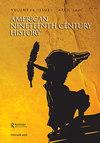Oceans of Grain: How American Wheat Remade the World
IF 0.1
2区 历史学
Q3 HISTORY
引用次数: 1
Abstract
her fiction. An actual cousin to the progenitor of plantation fiction, Thomas Nelson Page, Rives coveted his approval and eventually found her writing mentioned in the same company as his. Memorable is Rives’s use of an image made in 1889 to telegraph her privilege. In the photograph, Rives reclines on a well-appointed sofa while over her stands a Black woman in a domestic uniform, her eyes downcast to Rives’s figure, her posture inclined as though ready to spring at the wishes of the recumbent figure. Censer’s caption labels the image as one expressly taken to show “how Amélie Rives portrayed herself as a Virginia aristocrat” (p. 171). Whether Rives and her publicist consciously engineered such a linkage or periodicals manufactured these opportunities, “the effect was the same: Rives was pictured as a benevolent southerner of the old school” (p. 170). Rives thus illustrates the troublesome “benevolence” of progressive white womanhood, eager to explode the boundaries of circumscribed femininity, unwilling to disentangle those same freedoms from the net of whiteness. Censer finds Rives’s better formulated work later in her career when she relies less heavily on tired formulas of regional exceptionalism. InWorld’s-End (1914), she explores the toll of premarital pregnancy, for instance, and Shadows of Flames (1915) takes up opiate addiction. Here and earlier Censer maintains that Rives focused “on the passion, insouciance, and capabilities of her female protagonists” (p. 260). Rives emerged as something of a mentor to younger southern writers and enjoyed a friendship with fellow Virginian Ellen Glasgow, who famously exposed the treacheries of what she called “evasive idealism” in novels including The Sheltered Life (1932). Censer’s study may not so much engender a new generation of Rives devotees as it may instead redirect readers to how southern literature evolved in concert with a national literary marketplace. For her own part, Rives was chronically dissatisfied with her literary efforts, admitting in 1932 to a biographer she forcefully discouraged “I haven’t any illusions about myself as to my writing” (p. 251). If Rives had reservations about her own skill, readers will have none about Censer’s. The Princess of Albemarle is the fullest portrait of Rives’s life and work to date; it opens a window onto a period of American letters in which writing from the South seems simultaneously out of step with national rhythms and revelatory of their deepest impulses.《谷物海洋:美国小麦如何重塑世界
她的小说。里夫斯是种植园小说鼻祖托马斯·纳尔逊·佩奇的真正表亲,他渴望得到他的认可,最终发现她的作品与他的作品在同一家公司被提及。令人难忘的是里夫斯使用了一幅1889年制作的图像来表达她的特权。在这张照片中,里夫斯斜倚在一张设备齐全的沙发上,而她身后站着一位身穿家庭制服的黑人女性,她的眼睛垂向里夫斯的身影,她的姿势倾斜,似乎准备按照这位躺着的人物的意愿跳起来。Censer的说明将这张照片标记为一张明确拍摄的照片,以展示“Amélie Rives如何将自己描绘成弗吉尼亚贵族”(第171页)。无论是Rives和她的公关人员有意识地策划了这样的联系,还是期刊制造了这些机会,“效果都是一样的:Rives被描绘成一个仁慈的老派南方人”(第170页)。因此,里夫斯展示了进步白人女性令人烦恼的“仁慈”,她们渴望打破被限制的女性气质的界限,不愿意将这些自由从白人的网络中分离出来。Censer在她的职业生涯后期发现了Rives更好的作品,因为她不那么依赖于过时的地区例外论公式。例如,在《世界末日》(1914年)中,她探讨了婚前怀孕的代价,《火焰的阴影》(1915年)则探讨了鸦片成瘾。在这里和更早的时候,Censer坚持认为Rives专注于“她的女性主角的激情、漫不经心和能力”(第260页)。里夫斯是年轻的南方作家的导师,并与弗吉尼亚州的艾伦·格拉斯格(Ellen Glasgow)建立了友谊,后者在包括《被遮蔽的生活》(1932)在内的小说中揭露了她所说的“逃避的理想主义”的背信弃义。Censer的研究可能不会产生新一代的Rives爱好者,相反,它可能会引导读者了解南方文学是如何与国家文学市场协同发展的。就里夫斯而言,她长期对自己的文学努力感到不满,1932年她向一位传记作家承认,她强烈劝阻“我对自己的写作没有任何幻想”(第251页)。如果Rives对自己的技能有所保留,读者对Censer的技能就一无所知了。《阿尔伯马尔公主》是迄今为止里夫斯生活和工作的最完整写照;它打开了一扇了解美国信件时代的窗户,在这一时期,来自南方的写作似乎同时与国家节奏脱节,并揭示了他们最深层的冲动。
本文章由计算机程序翻译,如有差异,请以英文原文为准。
求助全文
约1分钟内获得全文
求助全文

 求助内容:
求助内容: 应助结果提醒方式:
应助结果提醒方式:


